[English] 日本語
 Yorodumi
Yorodumi- PDB-1h8u: Crystal Structure of the Eosinophil Major Basic Protein at 1.8A: ... -
+ Open data
Open data
- Basic information
Basic information
| Entry | Database: PDB / ID: 1h8u | ||||||
|---|---|---|---|---|---|---|---|
| Title | Crystal Structure of the Eosinophil Major Basic Protein at 1.8A: An Atypical Lectin with a Paradigm Shift in Specificity | ||||||
 Components Components | EOSINOPHIL GRANULE MAJOR BASIC PROTEIN 1 | ||||||
 Keywords Keywords | LECTIN / EOSINOPHIL GRANULE PROTEIN / EMBP | ||||||
| Function / homology |  Function and homology information Function and homology informationextracellular matrix structural constituent conferring compression resistance / defense response to nematode / negative regulation of macrophage cytokine production / negative regulation of interleukin-10 production / positive regulation of interleukin-4 production / transport vesicle / heparin binding / : / carbohydrate binding / ficolin-1-rich granule lumen ...extracellular matrix structural constituent conferring compression resistance / defense response to nematode / negative regulation of macrophage cytokine production / negative regulation of interleukin-10 production / positive regulation of interleukin-4 production / transport vesicle / heparin binding / : / carbohydrate binding / ficolin-1-rich granule lumen / defense response to bacterium / immune response / Neutrophil degranulation / extracellular exosome / extracellular region Similarity search - Function | ||||||
| Biological species |  HOMO SAPIENS (human) HOMO SAPIENS (human) | ||||||
| Method |  X-RAY DIFFRACTION / X-RAY DIFFRACTION /  SYNCHROTRON / SYNCHROTRON /  MOLECULAR REPLACEMENT / Resolution: 1.8 Å MOLECULAR REPLACEMENT / Resolution: 1.8 Å | ||||||
 Authors Authors | Swaminathan, G.J. / Weaver, A.J. / Loegering, D.A. / Checkel, J.L. / Leonidas, D.D. / Gleich, G.J. / Acharya, K.R. | ||||||
 Citation Citation |  Journal: J.Biol.Chem. / Year: 2001 Journal: J.Biol.Chem. / Year: 2001Title: Crystal Structure of the Eosinophil Major Basic Protein at 1.8A. An Atypical Lectin with a Paradigm Shift in Specificity Authors: Swaminathan, G.J. / Weaver, A.J. / Loegering, D.A. / Checkel, J.L. / Leonidas, D.D. / Gleich, G.J. / Acharya, K.R. | ||||||
| History |
|
- Structure visualization
Structure visualization
| Structure viewer | Molecule:  Molmil Molmil Jmol/JSmol Jmol/JSmol |
|---|
- Downloads & links
Downloads & links
- Download
Download
| PDBx/mmCIF format |  1h8u.cif.gz 1h8u.cif.gz | 63.5 KB | Display |  PDBx/mmCIF format PDBx/mmCIF format |
|---|---|---|---|---|
| PDB format |  pdb1h8u.ent.gz pdb1h8u.ent.gz | 47.8 KB | Display |  PDB format PDB format |
| PDBx/mmJSON format |  1h8u.json.gz 1h8u.json.gz | Tree view |  PDBx/mmJSON format PDBx/mmJSON format | |
| Others |  Other downloads Other downloads |
-Validation report
| Summary document |  1h8u_validation.pdf.gz 1h8u_validation.pdf.gz | 373.8 KB | Display |  wwPDB validaton report wwPDB validaton report |
|---|---|---|---|---|
| Full document |  1h8u_full_validation.pdf.gz 1h8u_full_validation.pdf.gz | 379.2 KB | Display | |
| Data in XML |  1h8u_validation.xml.gz 1h8u_validation.xml.gz | 5.1 KB | Display | |
| Data in CIF |  1h8u_validation.cif.gz 1h8u_validation.cif.gz | 9 KB | Display | |
| Arichive directory |  https://data.pdbj.org/pub/pdb/validation_reports/h8/1h8u https://data.pdbj.org/pub/pdb/validation_reports/h8/1h8u ftp://data.pdbj.org/pub/pdb/validation_reports/h8/1h8u ftp://data.pdbj.org/pub/pdb/validation_reports/h8/1h8u | HTTPS FTP |
-Related structure data
| Related structure data |  1litS S: Starting model for refinement |
|---|---|
| Similar structure data |
- Links
Links
- Assembly
Assembly
| Deposited unit | 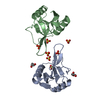
| ||||||||
|---|---|---|---|---|---|---|---|---|---|
| 1 | 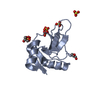
| ||||||||
| 2 | 
| ||||||||
| Unit cell |
| ||||||||
| Noncrystallographic symmetry (NCS) | NCS oper: (Code: given Matrix: (0.717976, -0.022182, 0.695715), Vector: |
- Components
Components
| #1: Protein | Mass: 13820.900 Da / Num. of mol.: 2 / Source method: isolated from a natural source / Source: (natural)  HOMO SAPIENS (human) / Cell: EOSINOPHIL / Cellular location: SECRETORY GRANULES / Organelle: PRIMARY GRANULE / Tissue: BLOOD / References: UniProt: P13727 HOMO SAPIENS (human) / Cell: EOSINOPHIL / Cellular location: SECRETORY GRANULES / Organelle: PRIMARY GRANULE / Tissue: BLOOD / References: UniProt: P13727#2: Chemical | ChemComp-SO4 / #3: Chemical | #4: Water | ChemComp-HOH / | Compound details | INVOLVED IN ANTIPARASITIC DEFENSE MECHANISMS AND IMMUNE HYPERSENSITIVITY REACTIONS. INDUCES ...INVOLVED IN ANTIPARASI | Has protein modification | Y | |
|---|
-Experimental details
-Experiment
| Experiment | Method:  X-RAY DIFFRACTION / Number of used crystals: 1 X-RAY DIFFRACTION / Number of used crystals: 1 |
|---|
- Sample preparation
Sample preparation
| Crystal | Density Matthews: 2.32 Å3/Da / Density % sol: 45 % | ||||||||||||||||||||||||||||||
|---|---|---|---|---|---|---|---|---|---|---|---|---|---|---|---|---|---|---|---|---|---|---|---|---|---|---|---|---|---|---|---|
| Crystal grow | pH: 6 Details: 100MM MALONIC ACID PH6, 140MM POTTASIUM DIHYDROGEN PHOSPHATE., pH 6.00 | ||||||||||||||||||||||||||||||
| Crystal grow | *PLUS Temperature: 20 ℃ / Method: vapor diffusion, hanging drop | ||||||||||||||||||||||||||||||
| Components of the solutions | *PLUS
|
-Data collection
| Diffraction | Mean temperature: 100 K |
|---|---|
| Diffraction source | Source:  SYNCHROTRON / Site: SYNCHROTRON / Site:  SRS SRS  / Beamline: PX14.1 / Wavelength: 1.244 / Beamline: PX14.1 / Wavelength: 1.244 |
| Detector | Type: ADSC CCD / Detector: CCD / Date: May 15, 2000 / Details: MIRRORS |
| Radiation | Protocol: SINGLE WAVELENGTH / Monochromatic (M) / Laue (L): M / Scattering type: x-ray |
| Radiation wavelength | Wavelength: 1.244 Å / Relative weight: 1 |
| Reflection | Resolution: 1.8→40 Å / Num. obs: 21127 / % possible obs: 96 % / Redundancy: 10.27 % / Biso Wilson estimate: 24 Å2 / Rsym value: 0.07 / Net I/σ(I): 16.2 |
| Reflection shell | Resolution: 1.8→1.86 Å / Mean I/σ(I) obs: 5.18 / Rsym value: 0.229 / % possible all: 91.8 |
| Reflection | *PLUS Lowest resolution: 40 Å / Num. measured all: 217030 / Rmerge(I) obs: 0.07 |
| Reflection shell | *PLUS % possible obs: 91.8 % / Rmerge(I) obs: 0.229 |
- Processing
Processing
| Software |
| ||||||||||||||||||||||||||||||||||||||||||||||||||||||||||||||||||||||||||||||||
|---|---|---|---|---|---|---|---|---|---|---|---|---|---|---|---|---|---|---|---|---|---|---|---|---|---|---|---|---|---|---|---|---|---|---|---|---|---|---|---|---|---|---|---|---|---|---|---|---|---|---|---|---|---|---|---|---|---|---|---|---|---|---|---|---|---|---|---|---|---|---|---|---|---|---|---|---|---|---|---|---|---|
| Refinement | Method to determine structure:  MOLECULAR REPLACEMENT MOLECULAR REPLACEMENTStarting model: PDB ENTRY 1LIT Resolution: 1.8→36.18 Å / Rfactor Rfree error: 0.008 / Data cutoff high absF: 905624.99 / Isotropic thermal model: RESTRAINED / Cross valid method: THROUGHOUT / σ(F): 0 Details: N-TERMINAL RESIDUES THR A1 AND CYS A2 WERE NOT SEEN IN ELECTRON DENSITY MAPS N-TERMINAL RESIDUE THR B1 WERE NOT SEEN IN ELECTRON DENSITY MAPS. NO SIDE CHAIN DENSITY SEEN FOR RESIDUES ARG B3 ...Details: N-TERMINAL RESIDUES THR A1 AND CYS A2 WERE NOT SEEN IN ELECTRON DENSITY MAPS N-TERMINAL RESIDUE THR B1 WERE NOT SEEN IN ELECTRON DENSITY MAPS. NO SIDE CHAIN DENSITY SEEN FOR RESIDUES ARG B3 AND ARG B98 WHICH WERE MODELED AS ALANINES IN THE FINAL STRUCTURE.
| ||||||||||||||||||||||||||||||||||||||||||||||||||||||||||||||||||||||||||||||||
| Solvent computation | Solvent model: FLAT MODEL / Bsol: 52.0733 Å2 / ksol: 0.386404 e/Å3 | ||||||||||||||||||||||||||||||||||||||||||||||||||||||||||||||||||||||||||||||||
| Displacement parameters | Biso mean: 27.1 Å2
| ||||||||||||||||||||||||||||||||||||||||||||||||||||||||||||||||||||||||||||||||
| Refine analyze |
| ||||||||||||||||||||||||||||||||||||||||||||||||||||||||||||||||||||||||||||||||
| Refinement step | Cycle: LAST / Resolution: 1.8→36.18 Å
| ||||||||||||||||||||||||||||||||||||||||||||||||||||||||||||||||||||||||||||||||
| Refine LS restraints |
| ||||||||||||||||||||||||||||||||||||||||||||||||||||||||||||||||||||||||||||||||
| LS refinement shell | Resolution: 1.8→1.91 Å / Rfactor Rfree error: 0.031 / Total num. of bins used: 6
| ||||||||||||||||||||||||||||||||||||||||||||||||||||||||||||||||||||||||||||||||
| Xplor file |
| ||||||||||||||||||||||||||||||||||||||||||||||||||||||||||||||||||||||||||||||||
| Software | *PLUS Name: CNS / Version: 1 / Classification: refinement | ||||||||||||||||||||||||||||||||||||||||||||||||||||||||||||||||||||||||||||||||
| Refine LS restraints | *PLUS
| ||||||||||||||||||||||||||||||||||||||||||||||||||||||||||||||||||||||||||||||||
| LS refinement shell | *PLUS Rfactor Rwork: 0.36 |
 Movie
Movie Controller
Controller


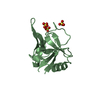


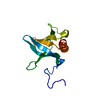

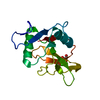

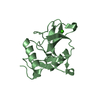
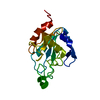
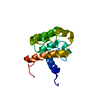
 PDBj
PDBj









